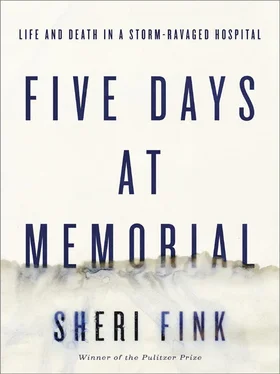Wynn’s staff, helped by some of their accompanying relatives, worked furiously. It was taking so long for the single elevator to arrive that they started carrying some patients down the stairwells. They rolled patients onto their sides, pushed a blanket up against their sweaty backs, then rolled them the other way and pulled the blanket out so it was lying underneath them. Volunteers grabbed onto the sides of the blankets, gathered up the slack, and lifted the patients from their beds.
Another surgical ICU nurse, Lori Budo, gripped a flashlight under her chin as she navigated the dark stairwell alongside a patient. When she came back up, she collected flashlights and tape and directed a volunteer to fix them to the railings.
One of the sickest patients in the ICU was seventy-seven-year-old Helen Breckenridge, a former drapery maker and interior decorator who had been a patient at Memorial for about a week. Breckenridge had developed complications of lung and heart disease and diabetes, and had been in hospice care at another hospital. That meant that the treatments she was receiving had been focused on affording her comfort rather than extending her life. She was receiving morphine and powerful sedatives and, when she stopped eating, perhaps as a result of the sedation or her worsening disease, the hospice had not provided nutrition or fluids. Her brother, a physician at another New Orleans hospital, couldn’t stand to watch her wither away. He believed she had been forced to sign paperwork that led to her hospice admittance and that she didn’t really want to be there. He went to court to have her removed from hospice and transferred to Memorial for aggressive treatment in the ICU.
Now, a team of medical workers labored to move Breckenridge. One squeezed air into her lungs by hand and others kept an eye on the multiple battery-powered pumps that delivered drugs into her veins to regulate her fragile circulatory system. They traveled downstairs from the eighth floor.
“Bring her back up,” a doctor said when she arrived downstairs. “She can’t go in the first sweep.”
Memorial’s doctors, meeting earlier, had established an exception to the protocol of prioritizing the sickest patients and those whose lives relied on machines. They had decided that all patients with Do Not Resuscitate orders would be prioritized last for evacuation. There were four DNR patients in the ICU, including Breckenridge and Jannie Burgess, the African American nurse who had once cared for patients at hospitals where she herself could not be treated.
A DNR order was signed by a doctor, almost always with the informed consent of a patient or health-care proxy. Informed consent was a legal concept established beginning in the 1950s in the United States. It was designed to protect patient autonomy in medical decision making, in the context of historical abuses. Doctors were required to disclose the nature, risks, benefits, and alternatives of the medical interventions they proposed. A DNR order meant one thing: a patient whose heartbeat or breathing had stopped should not be revived. A DNR order was different from a living will, which under Louisiana law allowed patients with a “terminal and irreversible condition” to request in advance that “life-sustaining procedures” be withheld or withdrawn.
But the doctor who suggested at the meeting that DNR patients go last had a different understanding, he later explained. Medical chairman Richard Deichmann said that he thought the law required patients with DNR orders to have a certified terminal or irreversible condition, and at Memorial he believed they should go last because they would have had the “least to lose” compared with other patients if calamity struck.
Other doctors at the meeting had agreed with Deichmann’s plan. Bill Armington, a neuroradiologist, later said he thought that patients who did not wish their lives to be prolonged by extraordinary measures wouldn’t want to be saved at the expense of others—though there was nothing in the orders or in Memorial’s disaster plans that stated this. This decision about evacuation priorities would perhaps not be a momentous one—as long as the hospital was emptied quickly.
Nurse manager Karen Wynn learned of the doctors’ decision from two doctors, Ewing Cook and Roy Culotta, and shared the information with Susan Mulderick. The plan was also made clear to a nurse helping transport Breckenridge: first “the most salvageable had to go.”
By the time Breckenridge was returned to the ICU, she was barely alive. They plugged her pumps and drips back into the emergency wall outlets and restored her mechanical ventilator, but she soon died, a death perhaps imminent but nonetheless seemingly the first in the hospital to be hastened by Katrina. A staff member summoned Dr. Horace Baltz to pronounce her death, and the white-haired doctor came panting up the staircase.
Rodney Scott, a sixty-three-year-old licensed practical nurse who’d once worked at Baptist, was brought down from the ICU, where he was recovering from a heart attack and multiple surgeries. But he weighed well over three hundred pounds, and a doctor feared he might get stuck in the narrow passageway being used to funnel patients into the garage. Worried this would back up the evacuation line, the doctor decided Scott should be the last patient to leave the hospital. Scott was taken to a patient unit on the fourth floor to wait.
UP ON THE HELIPAD, neonatologist Gershanik was deciding what to do about the two sick babies whose incubator didn’t fit on the small helicopter. Gershanik depended heavily on technology to keep his critically ill newborns alive. Transporting babies this sick without an incubator was unthinkable.
And then it wasn’t. Gershanik decided to take the risk. He climbed into the seat next to the pilot and cradled a six-week-old preemie wrapped in blankets in his arms. “Baby Boy S” had been born at twenty-four weeks with severely underdeveloped lungs and still weighed less than a kilogram. Gershanik dispensed rapid puffs of oxygen with squeezes of the reinflating bag, attempting to replicate the work of a sophisticated machine that sent oscillating waves of oxygen into the baby’s lungs. Someone placed the other tiny baby from the incubator into the arms of a nurse, who folded herself into the backseat of the helicopter. She slid the baby under her scrub shirt, decorated with pink and blue baby footprints.
As soon as they lifted off, Gershanik grew afraid. A cold draft circulated through the helicopter, and he tried to shield the baby with his body. It was getting dark. He could easily, without knowing it, dislodge the tiny tube in the baby’s windpipe. He had brought no machine to check the level of oxygen in the baby’s blood. The cacophony of the helicopter blades rendered his stethoscope useless. It would be impossible to listen to the baby’s chest for breath sounds. What did I do? he wondered. Did I make the right decision? Practically the only way to know whether the baby was still alive was to use his free hand to pinch the baby’s foot and feel whether he withdrew it. Gershanik’s other hand was getting cramped from rapidly squeezing the oxygen bag. He made a silent promise: If this baby lives, I’ll never complain about anything again.
The pilot announced that he had to stop for fuel. Gershanik couldn’t believe it. They landed at a refueling site for petroleum-industry helicopters. A planned five-minute stop stretched into ten, then fifteen, then twenty-five minutes. Gershanik pulled out his penlight and shined it on the baby. Still alive. He swung the light to the baby’s oxygen tank. Nearly empty. Two US Army helicopters had landed after them, but were getting served first. Gershanik protested to the pilot. “Sir, the babies are not going to make it.” The pilot told him the Army helicopters were rescuing people from rooftops. “Otherwise they’ll die as well.”
Читать дальше













